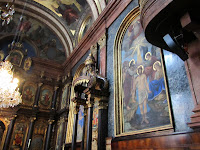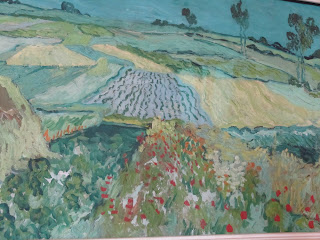I'm finally back home - it was a long flight! It feels good to be home in my own bed and eating dinners with my family, but it is weird to drive a car again and to buy a week's worth of groceries in one day. Even in the simple things - no pastry and melange for breakfast, no lunch at the deli in the city, no walking a mile before even eating breakfast, much less lunch! Going from living in a city for a month where everything is packed into a relatively small area, and where each encounter is an intense burst of energy - whether it be riding the U-Bahn or fighting through the crowds in the city center to get to class on time - to living back in the states where there is so much space and silence and no ability to just walk and explore and wander without boredom is such an odd transition.

Not only is it difficult transitioning back into a daily routine where walking seven miles and being out from 9am to 9pm is not required, but it is difficult to translate what I have seen into everyday conversation.
People ask me what I liked best, what thing was my favorite, to see pictures, and to hear my stories. I find it hard, though, to explain my answers to them, especially because all a person really wants to hear is the sentence-long answer with the most exciting details. However, the exciting bits were not the fabric of my trip; rather, the everyday mundane activities and interactions were the bulk of my experience. Making new friends, hiding away in the booth of a coffeehouse to people watch, eating scoop upon scoop of gelato, running to catch the subway to make it to class, getting lost and agonizing over the map looking like tourists, and then finally being addressed in German while walking - blending in and being mistaken for an actual Austrian - those were the pieces of the trip I remember best and which I treasure the most. So when I am asked about my favorites and about the bests, I don't have an answer. Nor do I show the 5,000 pictured I managed to take. Rather, I stumble over my words and give a noncommittal round-about answer about the Alps and the sacher cakes and the churches.

Not only is it difficult to describe my trip and identify its very essence and bones, but it is even harder to relate my experiences with the Viennese identity and experience. Throughout the month I have had the opportunity to talk with Austrians and Americans living in Austria about their view on Austria (politics, religion, and society), and I have seen Austria's own interpretation of itself through its museums and monuments. My attempts to reconcile the facts of history with personal perspectives and with the reality of Austrian architecture and monuments has not been easy. How does one reconcile that Hitler was a product of Austria and that Austrians were overjoyed when annexed into Germany, yet with hindsight Hitler was one of the most destructive and abusive men in history? How does an Austrian reconcile the monument to the Jewish man wrapped in barbed wire while honoring those Austrian non-Jews who were simply "victims of war and fascism" - do they honor one above the other or both equally? Is maintaining the concentration camps a form of glorifying the Holocaust, abusing its history (while ignorant tourists laugh and play within the barren barracks), or educating the public?
I honestly do not believe that it is possible, nor necessary, to find a harmonious balance and reconciliation between these truths - sometimes all we can do as humans is actively participate in the history of the present and learn about the history of the past. These things may not make absolute sense together, but they have occurred and they do exist, and so we must accept them and try to understand them as individual aspects of Austrian culture.

This trip has allowed me a rare and amazing glimpse into a people's pieced together culture - a culture not clearly defined; suppressed under a monarchy, dragged into a war, and then the victim and participant in a subsequent war. This nation without a defined character has taught me the uniqueness of its culture, drawing me into its fibers and allowing me to languish in its imperial majesty. Not only have I had the opportunity to meet people from the world over, but I have seen history face to face, touched its relics, and studied its traces. Vienna has been such a rewarding experience, and to say that I learned more in one month abroad than two years at Davis would be an understatement - I have never retained a subject matter so intensely and with so much detail as I have in learning about the Habsburgs. Translating my experiences into daily conversation may take some time, as I am still digesting some of the most intense moments (Mauthausen, etc), but what I gained from this trip I will always carry with me.







































 His crazy heads were made in Bratislava, however, where he had bought a house. He was rumored to be schizophrenic, and he created these heads to scare away the demons and pain he felt in the night.
His crazy heads were made in Bratislava, however, where he had bought a house. He was rumored to be schizophrenic, and he created these heads to scare away the demons and pain he felt in the night. Renoir's classical womanly figure was the epitome of beauty for the impressionists, and the landscapes depcted by both Monet and Van Gogh attempted at capturing the true essence of an experience or scene - realism was a top priority in their art. David's Napoleon Bonaparte also dominated one of the rooms, an example of the historicism which many artists desired to portray.
Renoir's classical womanly figure was the epitome of beauty for the impressionists, and the landscapes depcted by both Monet and Van Gogh attempted at capturing the true essence of an experience or scene - realism was a top priority in their art. David's Napoleon Bonaparte also dominated one of the rooms, an example of the historicism which many artists desired to portray.



